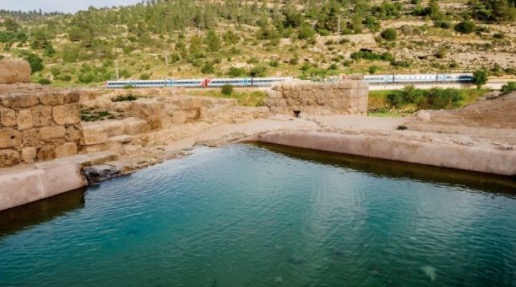An incredible discovery has been made at an ancient Christian site in the city of Jerusalem. A team of archeologists recently unearthed a stunning pool and fountain right next to a Church near the Holy City.
The pool is part of a system of pools unearthed at Ein Hanniya Park between 2012 and 2016, officials detailed Wednesday. Built during the Byzantine era, the pools date back to between the 4th and 6th centuries A.D., as reported by the Israel Antiquities Authority.
Among other discoveries was a rare silver coin from the 4th century B.C. and an ancient capital, or part of a pillar. But it is the pool that is gaining particular attention in the archaeological community, as reported by Fox News.

“The most significant finding in the excavation is a large and impressive pool from the Byzantine period,” explained Irina Zilberbod, the excavation director for the Israel Antiquities Authority (IAA). “This pool was built in the center of a spacious complex at the foot of a church that once stood here. Roofed colonnades were built around the pool that gave access to residential wings.”

Despite the discovery being an extension of a previously unearthed network of structures, there is still much mystery that surrounds this incredible find.
“It’s difficult to know what the pool was used for – whether for irrigation, washing, landscaping or perhaps as part of baptismal ceremonies at the site,” said Zilberbod. The pool’s water drained through a network of channels into a fountain.

The site has also been linked to the New Testament scriptural account of an Ethiopian Eunuch’s conversion to Christianity by St. Philip the Evangelist. “We believe that some early Christian commentators identified Ein Hanniya as the site where the Ethiopian eunuch was baptized, as described in Acts 8:26–40,” Jerusalem District Archaeologist Dr. Yuval Baruch said in a statement.
“The eunuch said, ‘Look! Here is water. What prevents me from being baptized?’ [ 37Philip replied, ‘If you believe with your whole heart you may be baptized.’ The man said, ‘I believe that Jesus Christ is the Son of God.’ Having said that,] 38he commanded the chariot to halt. Both he and Philip went down together into the water, and there Philip immersed the eunuch.” – Acts 8:34-38.
“The baptism of the eunuch by St. Philip was one of the key events in the spread of Christianity. Therefore, identifying the place where it occurred occupied scholars for many generations and became a common motif in Christian art.”
The IAA hopes that the stunning aesthetic combined with the rich history of the site will attract many visitors.
“The result is an extraordinarily beautiful site incorporating archaeology, an ancient landscape and a unique visitor experience,” the IAA said in a statement, as reported by The Times of Israel.
The area has become notorious for revealing breathtaking mysteries of the past. Just last year, archaeologists uncovered a beautiful 1,500-year-old Christian mosaic that was once the floor of a church or monastery in the ancient coastal city of Ashdod-Yam.
Then, in 2017, an ancient Greek inscription was discovered on a 1,500-year-old mosaic floor near the Damascus Gate in the Old City of Jerusalem. The region really has become a treasure trove of ancient discoveries. Back In 2015 a 1,500-year-old church was unearthed at a Byzantine-era rest stop between Tel Aviv and Jerusalem. Then, in 2014 the remains of another church from the same period were discovered in southern Israel.



